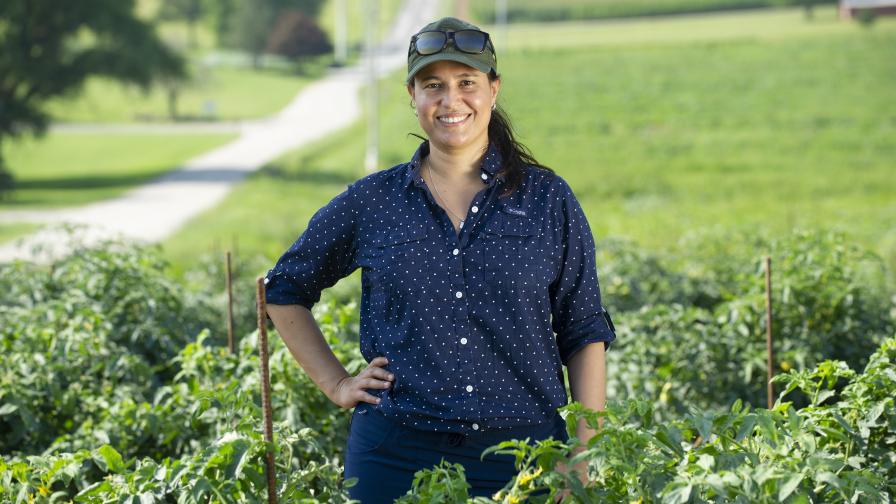Tomato Grower Takes On Labor, Immigration

“What you learn from growing up in a farm family is to roll up your sleeves and do whatever is required at whatever time of day.”
That’s what Luawanna Hallstrom, the chief operating officer (COO) and general manager of California’s Harry Singh & Sons, and business manager for Oceanside Produce, says regarding her family’s work ethic. Harry Singh & Sons is said to be the largest single vine-ripe tomato producer in the U.S.
Judging from her contributions to ag, particularly in the area of labor and immigration reform, Hallstrom has adopted those work ethics, as well. She is known for her travels across the country, meeting with lawmakers to discuss issues such as farmworker housing and other topics related to labor and immigration.
Her “day job,” or the operation she runs with her family, is in Oceanside, CA, where up to 1,000 acres of vine-ripe tomatoes are produced. Started in 1940 by her grandfather, Harry Singh Sr., an immigrant from Punjab, India, the farm has since been managed by Harry Singh Jr.. In addition to Hallstrom, eight other family members also are at the helm. The farm also employs up to 1,200 workers, of which about 450 live in dormitory housing.
Getting Started
How did Hallstrom wind up as COO of the farm? It all goes back to her work ethic and putting family first. When she received the request to come to work for the farm, Hallstrom had just received a degree from California Polytechnic State University and she was making plans to attend chiropractic school.
“My family, at that time, was expanding the business to include a produce marketing company, Oceanside Produce, where we could sell our own product,” she explains. “They asked me to reconsider my plans and help out through this new venture. It was one of the best decisions I ever made.”
When she took over her new role, Hallstrom says she had to learn the operation from the ground up. “When I started in 1986, there was one person at the Harry Singh & Sons office (me) and four in Oceanside Produce, primarily a sales group,” she recalls. “I had to learn the payroll side of the business, and once I got that done, my goal was to start to build a foundation, a structure, and learn the business from the bottom up. I needed to understand laws on the labor side and learn about our product and what we were trying to sell and market.
Future Flow
It was also in 1986 when the Immigration Control Reform Act was passed, she says. Despite the fact that her knowledge about politics or lawmaking was limited at that time, she says she was truly confused by legislation that didn’t contain any forward thinking to include the future flow of farmworkers. “I didn’t understand why they weren’t concerned with the future and housing for workers,” she adds.
Taking matters into her own hands, Hallstrom decided she needed to work on this issue. “I saw a train wreck coming and that ag would find itself in the same place it was before, with a very limited draw of ag labor,” she explains. “One good thing that came out of that legislation is that the family realized the potential to get support for building decent housing for workers, a long-time dream of the late Harry Singh Sr.”
Before launching into a housing project, Hallstrom and her family traveled around the state to see what else was out there. Much of what she saw was fairly dilapidated. The idea behind the trip, she says, was to find out what people had done in the past and what obstacles they faced. “That is how we came up with our dormitory-style housing,” she explains.
Hallstrom was then tasked with figuring out a way to provide workers with efficient housing. Because no financial help was available, the family had to acquire private funding. The initial budget was $1.5 million, but by the time the project was finished, the price had jumped to $2.5 million.
“Nobody had ever really done anything like this,” she says. “Every time we turned the corner, there was another demand, and we couldn’t open our doors unless we got it done. It was a lot of money, but it was the best decision we ever made.
“We noticed immediately that our employees’ efficiency, well-being, and health increased,” she continues. “They weren’t being vandalized, they felt
better, and the result was higher work efficiency and fewer work days missed due to illness. We saw this effect immediately.”
Housing And H-2A
Another important point to make about the housing, says Hallstrom, is that after the events of Sept. 11, 2001, the farm would not have been able to get into the H-2A program if it hadn’t established housing.
“We never knew that this would happen, but that [the housing] was the thing that saved us,” she explains. “Providing housing is required to participate in the H-2A program.”
From her travels across the country, learning about how other growers are impacted by labor and immigration issues, Hallstrom found out that many were concerned that they would be unable to afford housing for their migrant workers.
The bottom line, she says, is that growers need to find worker housing they can afford and have it be something that matches the worker needs. “There needs to be a match and flexibility.”
Is AgJOBS Enough?
Moving the discussion of labor and immigration to what is going on today, does Hallstrom think the current AgJOBS bill that was reintroduced in Congress in May does enough for the agriculture industry?
by Governor Arnold Schwarzenegger for a second term to the
to the State Board of Food and Agriculture.
In a nutshell, she does. The current bill will provide agriculture with what it needs, she says.
“The legislation will provide ag with a way to legitimize the current year-round workforce that is running ag on a day-to-day basis,” comments Hallstrom. “It also takes a serious look at future flows, and it is done in a bipartisan way, focusing on both the worker advocate and the ag business. It assures that there is a program set in place for future flow, when it is needed, and a way to protect the foundation that is there now serving the industry.
“We have learned that in order to really get anything passed, you have to have bipartisan support and you have to come to the center and work,” she continues. “Anybody who thinks they will get everything they want isn’t living in the real world. That is a pipe dream.”
Hallstrom says AgJOBS is the only piece of legislation that has stood the test of time. Despite the fact that the legislation has been kicked around in Congress before, Hallstrom remains confident that it will pass later this year or early in 2010.
“A recent meeting held by President Obama was positive,” she says. “The tone of the meeting was that Obama has been clear about a commitment and he wants to finish something this year or the beginning of next year. And it was also made clear by Senator John McCain that a future worker flow program must be included.”
Future Goals
Throughout her years working for her family’s farm and being a strong and vocal supporter of labor and immigration reform, Hallstrom also learned that there was a significant disconnect within the ag community itself. A goal she set for herself was to connect the ag community, and help growers better understand each other and the federal laws that are important to sustaining ag and sustaining national security.
“Then my goal is to connect the rest of the country,” she explains. “We all have a stake in this.”
Hallstrom says many peopleare so far removed from ag they forget that, at one point, each family had to grow its own food. It was because of technological
advancements that people were able to grow food beyond what they needed for their own families.
“This freed up others to civilize the country and provide other raw materials and services,” she says. “American people need to understand the responsibility growers have to feed the nation, and it will take all size farms.”










